Influence of Magnetic Field on Amplification without Inversion Induced by a Femtosecond Pulse Train
Abstract
:1. Introduction
2. Theoretical Model
3. Results and Discussion
4. Conclusions
Author Contributions
Funding
Institutional Review Board Statement
Informed Consent Statement
Data Availability Statement
Conflicts of Interest
References
- Kocharovskaya, O. Amplification and lasing without inversion. Phys. Rep. 1992, 219, 175–190. [Google Scholar] [CrossRef]
- Mandel, P. Lasing without inversion: A useful concept? Contemp. Phys. 1993, 34, 235–246. [Google Scholar] [CrossRef]
- Zibrov, A.S.; Lukin, M.D.; Nikonov, D.E.; Hollberg, L.; Scully, M.O.; Velichansky, V.L.; Robinson, H.G. Experimental demonstration of laser oscillation without population inversion via quantum interference in Rb. Phys. Rev. Lett. 1995, 75, 1499–1502. [Google Scholar] [CrossRef] [Green Version]
- Wu, J.H.; Gao, J.Y. Phase control of light amplification without inversion in a Λ system with spontaneously generated coherence. Phys. Rev. A 2002, 65, 063807. [Google Scholar] [CrossRef]
- Jha, P.K. Effective unidirectional pumping for steady-state amplification without inversion. J. Mod. Opt. 2011, 58, 1957–1965. [Google Scholar] [CrossRef] [Green Version]
- Sun, Z.; Jia, F.D.; Lv, S.F.; Ruan, Y.P.; Qing, B.; Xue, P.; Xu, X.Y.; Dai, X.C.; Zhong, Z.P. The Inversionless Amplification in a Tripod System of 87Rb Atoms in a Magneto-optical Trap. Chin. Phys. Lett. 2014, 31, 043201. [Google Scholar] [CrossRef]
- Al-Nashy, B.; Abdullah, M.; Al-Shatravi, A.G.; Al-Khursan, A.H. Lasing without population inversion in a four-level Y-type configuration in double quantum dot system. Pramana 2018, 91, 74. [Google Scholar] [CrossRef]
- Nottelmann, A.; Peters, C.; Lange, W. Inversionless amplification of picosecond pulses due to Zeeman coherence. Phys. Rev. Lett. 1993, 70, 1783–1786. [Google Scholar] [CrossRef]
- van der Veer, W.E.; van Diest, R.J.J.; Dönszelmann, A.; van Linden van den Heuvell, H.B. Experimental demonstration of light amplification without population inversion. Phys. Rev. Lett. 1993, 70, 3243–3246. [Google Scholar] [CrossRef] [Green Version]
- Zhang, G.; Hu, S.; Li, J.; Jin, Y.; Liu, Y.; Li, S. Transient amplification without population inversion in a two-field-driven ladder-type three-level system. Optik 2020, 200, 163418. [Google Scholar] [CrossRef]
- Scully, M.O.; Zhu, S.Y.; Gavrielides, A. Degenerate quantum-beat laser: Lasing without inversion and inversion without lasing. Phys. Rev. Lett. 1989, 62, 2813. [Google Scholar] [CrossRef]
- Mysyrowicz, A.; Danylo, R.; Houard, A.; Tikhonchuk, V.; Zhang, X.; Fan, Z.; Liang, Q.; Zhuang, S.; Yuan, L.; Liu, Y. Lasing without population inversion in N2+. APL Photonics 2019, 4, 110807. [Google Scholar] [CrossRef]
- Richter, M.; Lytova, M.; Morales, F.; Haessler, S.; Smirnova, O.; Spanner, M.; Ivanov, M. Rotational quantum beat lasing without inversion. Optica 2020, 7, 586–592. [Google Scholar] [CrossRef]
- Moreno, M.P.; Vianna, S.S. Coherence induced by a train of ultrashort pulses in a Λ-type system. JOSA B 2011, 28, 1124–1129. [Google Scholar] [CrossRef]
- Aumiler, D. Coherent population trapping in 87Rb atoms induced by the optical frequency comb excitation. Phys. Rev. A 2010, 82, 055402. [Google Scholar] [CrossRef]
- Felinto, D.; Bosco, C.; Acioli, L.; Vianna, S. Coherent accumulation in two-level atoms excited by a train of ultrashort pulses. Opt. Commun. 2003, 215, 69–73. [Google Scholar] [CrossRef]
- Felinto, D.; Acioli, L.H.; Vianna, S.S. Accumulative effects in the coherence of three-level atoms excited by femtosecond-laser frequency combs. Phys. Rev. A 2004, 70, 043403. [Google Scholar] [CrossRef]
- Walls, D.F.; Milburn, G.J. Quantum Optics; Springer Science & Business Media: New York, NY, USA, 2007. [Google Scholar]
- Steck, D.A. Rubidium 87 D Line Data. 2001. Available online: https://steck.us/alkalidata/ (accessed on 10 November 2021).
- Soares, A.A.; de Araujo, L.E.E. Influence of propagation on the coherent accumulation of excitation induced by an ultrashort pulse train. Phys. Rev. A 2009, 80, 013832. [Google Scholar] [CrossRef] [Green Version]
- Vujičić, N.; Ban, T.; Kregar, G.; Aumiler, D.; Pichler, G. Velocity-selective double resonance in Doppler-broadened rubidium vapor. Phys. Rev. A 2013, 87, 013438. [Google Scholar] [CrossRef]
- Vujičić, N.; Kregar, G.; Ban, T.; Aumiler, D.; Pichler, G. Frequency comb polarization spectroscopy of multilevel rubidium atoms. Eur. Phys. J. D 2014, 68, 9. [Google Scholar] [CrossRef]
- Soares, A.; de Araujo, L.E. Coherent accumulation of excitation in the electromagnetically induced transparency of an ultrashort pulse train. Phys. Rev. A 2007, 76, 043818. [Google Scholar] [CrossRef] [Green Version]
- Dong, H.M.; Nga, L.T.Y.; Bang, N.H. Optical switching and bistability in a degenerated two-level atomic medium under an external magnetic field. Appl. Opt. 2019, 58, 4192–4199. [Google Scholar] [CrossRef] [PubMed]

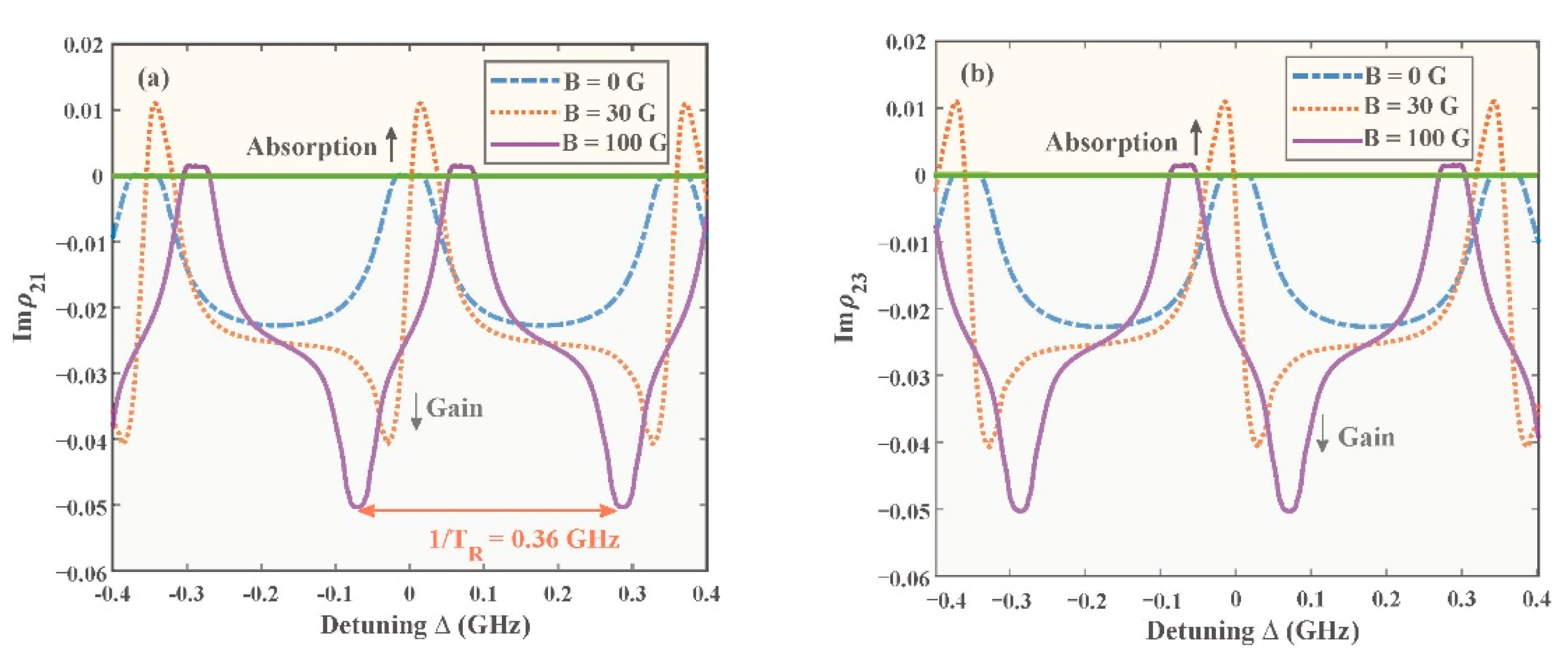
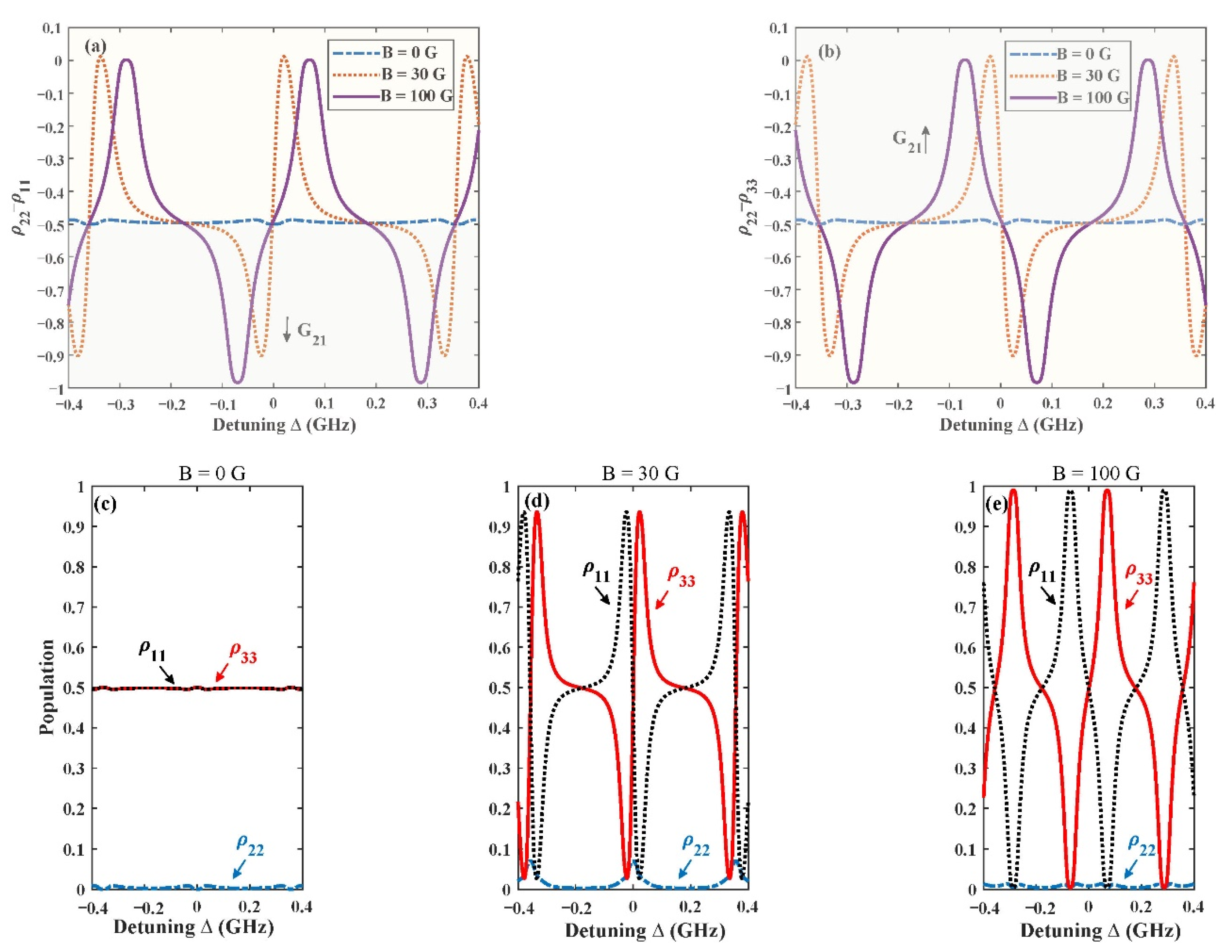
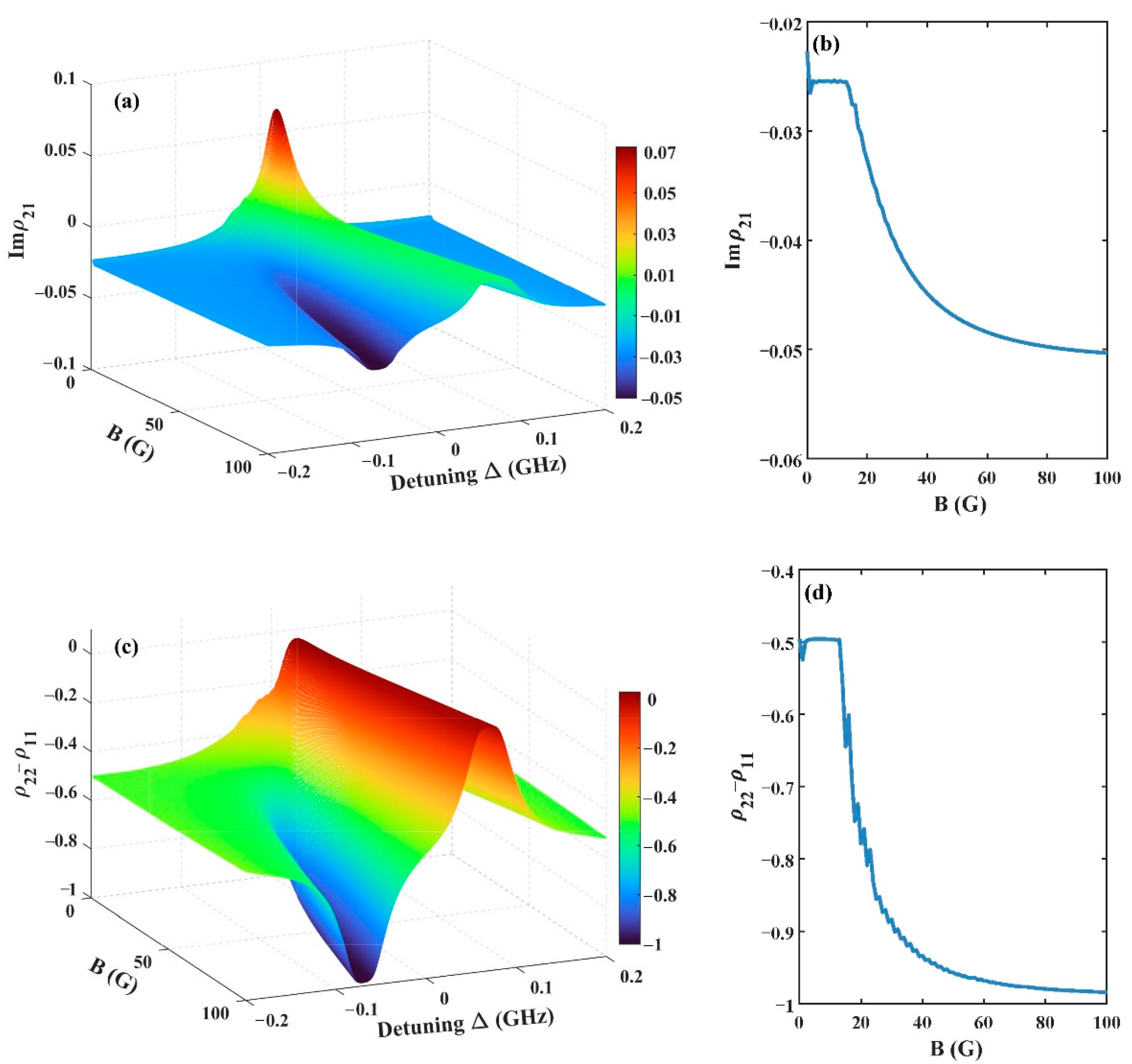
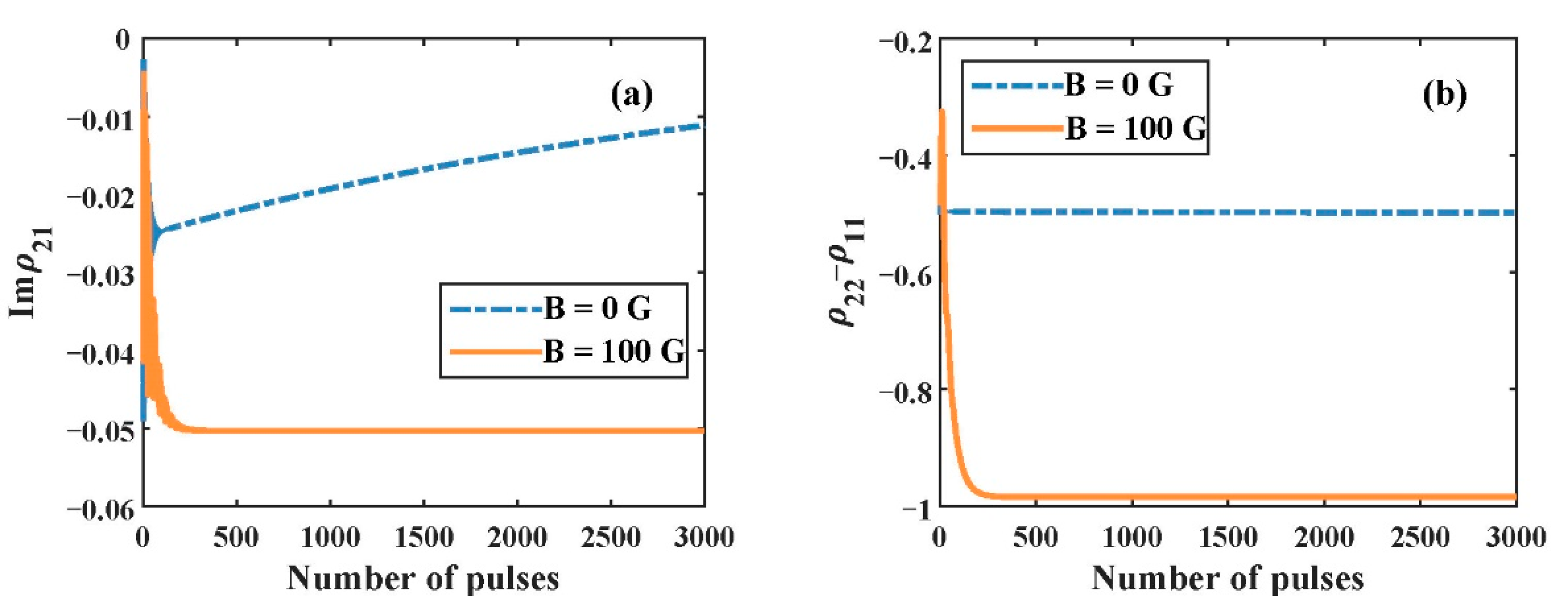
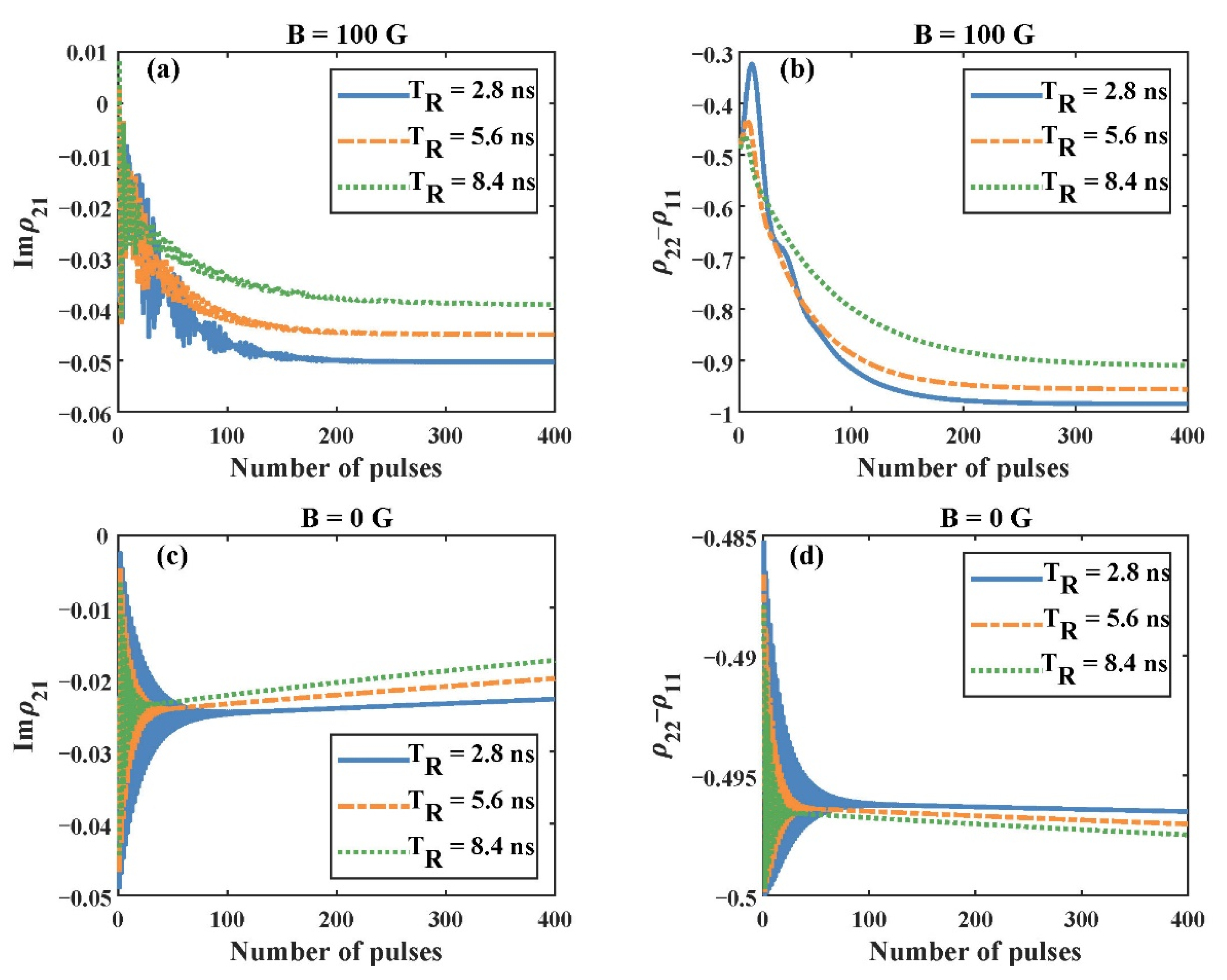

Publisher’s Note: MDPI stays neutral with regard to jurisdictional claims in published maps and institutional affiliations. |
© 2022 by the authors. Licensee MDPI, Basel, Switzerland. This article is an open access article distributed under the terms and conditions of the Creative Commons Attribution (CC BY) license (https://creativecommons.org/licenses/by/4.0/).
Share and Cite
Ji, Q.; Ma, R.; Jiang, T.; Luo, B. Influence of Magnetic Field on Amplification without Inversion Induced by a Femtosecond Pulse Train. Appl. Sci. 2022, 12, 1780. https://doi.org/10.3390/app12041780
Ji Q, Ma R, Jiang T, Luo B. Influence of Magnetic Field on Amplification without Inversion Induced by a Femtosecond Pulse Train. Applied Sciences. 2022; 12(4):1780. https://doi.org/10.3390/app12041780
Chicago/Turabian StyleJi, Qianqian, Rui Ma, Tianwei Jiang, and Bin Luo. 2022. "Influence of Magnetic Field on Amplification without Inversion Induced by a Femtosecond Pulse Train" Applied Sciences 12, no. 4: 1780. https://doi.org/10.3390/app12041780





